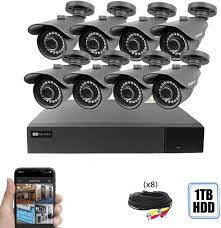Vision systems have revolutionized countless industries, from manufacturing and healthcare to autonomous vehicles and robotics. These systems are integral to the development of artificial intelligence (AI) and machine learning (ML) applications, allowing machines to perceive and interpret visual information like never before. In this article, we will explore the evolution of vision systems and highlight some of the best technologies currently available. Alibaba.com
The Evolution of Vision Systems
Vision systems have come a long way since their inception. Early computer vision systems were rudimentary, capable of only simple tasks such as image processing and basic pattern recognition. However, with advances in hardware and software, vision systems have grown exponentially in sophistication and capability.
- Machine Vision
Machine vision systems, one of the earliest forms of computer vision, paved the way for modern vision technology. These systems use cameras and image processing software to inspect, measure, and analyze objects in real-time. In manufacturing, machine vision ensures the quality and consistency of products, while in healthcare, it aids in medical image analysis and diagnostics.
Key features of machine vision systems include pattern recognition, object tracking, and optical character recognition (OCR). They have found applications in various industries, from food production and automotive manufacturing to pharmaceuticals and electronics.
- Deep Learning and Convolutional Neural Networks (CNNs)
One of the most significant breakthroughs in computer vision came with the advent of deep learning and convolutional neural networks (CNNs). CNNs are specialized neural networks designed to process grid-like data, such as images and videos. They have played a pivotal role in advancing image recognition and object detection.
CNN-based vision systems can recognize complex patterns and objects in images, making them indispensable for applications like facial recognition, autonomous vehicles, and surveillance systems. Their ability to learn and adapt from large datasets has pushed the boundaries of what vision systems can achieve.
- LiDAR Technology
LiDAR (Light Detection and Ranging) is a sensing technology that uses laser pulses to measure distances and create detailed 3D maps of the environment. While not a traditional camera-based vision system, LiDAR is a crucial component of autonomous vehicles, robotics, and drones. It enables these systems to navigate and perceive their surroundings with remarkable precision, even in challenging conditions like low light or adverse weather.
The combination of LiDAR with other vision technologies like cameras and radar has led to significant advancements in autonomous navigation, safety, and obstacle avoidance.
- Augmented Reality (AR)
Augmented reality blends the virtual world with the real world, enhancing our perception of reality through digital overlays. AR vision systems utilize cameras and sensors to identify the user's environment and superimpose computer-generated graphics or information onto it. This technology has applications in gaming, education, architecture, and healthcare, among others.
The success of AR depends on its ability to precisely track the user's position and orientation in real-time, which requires advanced vision systems capable of robust and accurate tracking.
- Natural Language Processing (NLP) and Computer Vision Fusion
Recent advancements in NLP and computer vision have led to exciting developments in multimodal AI systems. These systems can understand and generate both text and images, enabling a more holistic understanding of the world. For example, they can generate image captions, perform sentiment analysis on images, or assist in content moderation on social media platforms.
By combining NLP and computer vision, these systems are making strides in content recommendation, accessibility, and enhancing user experiences across various domains.
The Best Vision Systems Today
Now that we have explored the evolution of best vision systems, let's delve into some of the best technologies available today:
- NVIDIA Jetson Series
NVIDIA's Jetson series is a prime example of high-performance, edge-computing vision systems. These compact, energy-efficient modules are equipped with powerful GPUs and are specifically designed for AI and computer vision applications. They are used in robotics, drones, autonomous vehicles, and industrial automation.
The Jetson series enables real-time object detection, image classification, and semantic segmentation, making it a go-to choice for developers in various industries.
- Google Cloud Vision
Google Cloud Vision is a cloud-based vision system that offers a wide range of features, including image labeling, OCR, and facial recognition. It can analyze and extract valuable insights from images and videos, making it valuable for businesses in fields like e-commerce, content moderation, and sentiment analysis.
Google's extensive experience in machine learning and cloud computing ensures the reliability and scalability of this vision system.
- OpenCV (Open Source Computer Vision Library)
OpenCV is an open-source computer vision library that has become an essential tool for developers and researchers in the field. It provides a comprehensive set of tools and libraries for image and video analysis, manipulation, and machine learning. Its versatility and community support make it an invaluable resource for building custom vision applications.
- Tesla's Full Self-Driving (FSD) Suite
Tesla's Full Self-Driving suite is a prime example of how vision systems are pushing the boundaries of autonomous vehicles. It combines cameras, ultrasonic sensors, radar, and powerful AI processing to enable advanced driver-assistance features and eventual full autonomy. Tesla's vision-based approach to self-driving has garnered significant attention and controversy, but it remains at the forefront of the industry.
Conclusion
Vision systems have evolved from simple image processing tools to powerful AI-driven technologies that are transforming industries and our daily lives. From machine vision systems that ensure product quality to deep learning and LiDAR technologies that power autonomous vehicles, the possibilities are continually expanding.
As technology continues to advance, we can expect even more exciting developments in the field of computer vision. Whether it's improving healthcare diagnostics, enhancing augmented reality experiences, or making our roads safer with autonomous vehicles, vision systems are at the heart of innovation in the 21st century. Visit official website qviro.com

